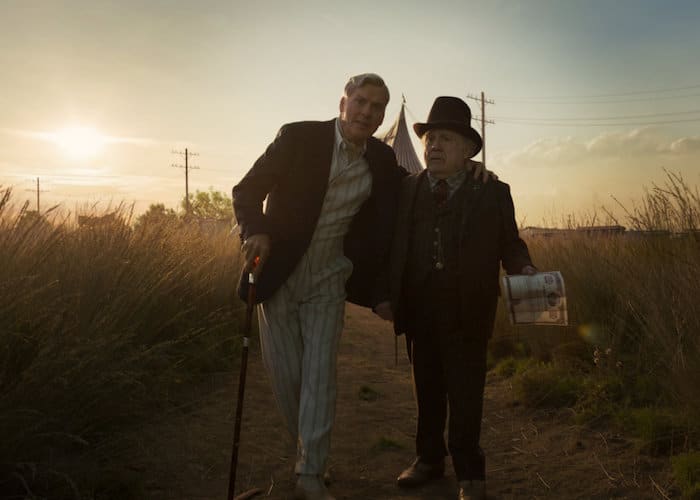
If you’re a diehard fan of the 1941 animated version of Dumbo, then you’re likely to be curious about Tim Burton‘s live-action adaptation. Especially if you were disappointed when the planned animated sequel was canceled more than a decade ago. It’s a reimagined story with a continuation of the plot. Many things are changed from the original (as was that film from the book) but you still get the feeling of a follow-up that shows you what happened next for the flying elephant.
Whether you come away satisfied or not is up to your own tastes. Reviews for the movie are split almost 50/50 per Rotten Tomatoes. Personally, I’m not a fan (though I do love the production design, much of which I had the fortune to see up close while visiting the set), but I am inspired by its ambitious intentions to recommend some older movies that are essential to watch next. If you don’t see the new Dumbo, that’s fine, just take these picks as what to watch after the 1941 version.
Batman Returns (1992) and Big Fish (2003)
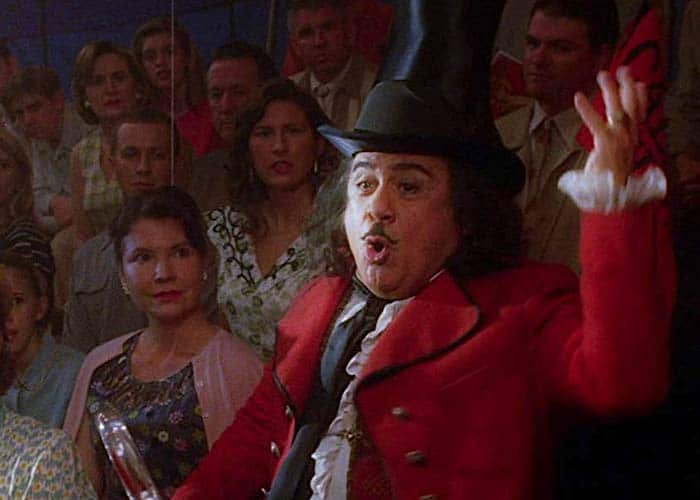
Okay, so this double entry might not work for you if you’re just going by the 1941 film. Still, I can’t help but want to recommend better Burton. His Dumbo isn’t necessarily the best thing he’s done in years but it does seem like a culmination of his career, from the scene where a guy rescues animals from a fire (a la Pee-wee’s Big Adventure) to the robot hands and return of Alan Arkin (Edward Scissorhands) to the production’s nickname being “Big Ears” (Big Eyes), and more.
The two of Burton’s movies that are most tied to Dumbo, however, are his Batman sequel, Batman Returns, and his most favored 21st-century release, Big Fish. Both movies, like Dumbo, feature Danny DeVito, as does Mars Attacks!, but in both of these movies, like in Dumbo, his character is some sort of circus ringleader. In Batman Returns, he’s the villain known as the Penguin but he’s also the leader of a criminal former circus troupe (and like in Dumbo, his adversary is played by Michael Keaton). In Big Fish, he’s a more obvious circus showman. Apparently, when Burton called DeVito up about the Dumbo role, he noted this would complete their circus trilogy together.
Gus (1976)
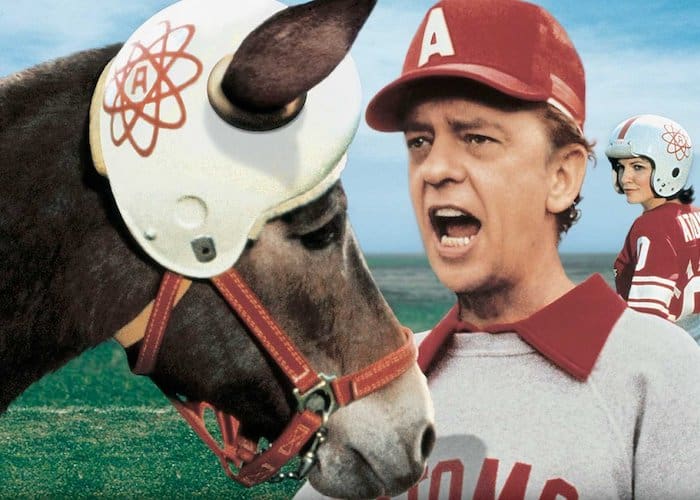
Before I saw the new Dumbo for myself, I had to read the first round of reviews of the movie, and one of them stuck out. Alonso Duralde’s take for The Wrap compares the remake to other Disney movies, specifically the cheesy live-action kiddie fare from the ’70s, such as The Million Dollar Duck and Gus. The claim was on my mind while watching Dumbo, and the new movie did especially remind me of the latter. And not in a good way, either, even if I am now suggesting you watch the very thing.
Gus isn’t great, but it’s a proper example of that era of Disney family films to give you context for what Duralde means (and just to be more familiar with the history of Disney and family films in general). The plot involves an animal with a special talent that makes him famous, and there’s a snively villain who wants to take over the business that special animal is making money for. There are no meddling kids (Michael Keaton comes off as a total Scooby-Doo baddie at one point in Dumbo), but there might as well be. I guess the audience was the meddling kids, being entertained by the henchmen falling victims to slapstick.
Maa (1976)
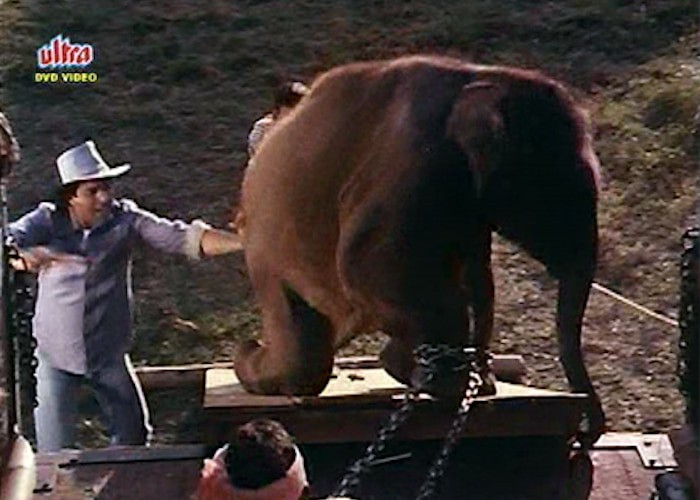
Now we go to Dumbo’s homeland, India, for another kind of family-friendly film. Maa is a Bollywood musical drama about a man who makes his living trapping wild animals for circuses. But he makes the mistake of separating mothers from their babies, which is a circumstance for the story in Dumbo, as well. At the center of Maa are a baby elephant (not a big-eared no flying one, unfortunately) brought to the city and his mother, who goes on a rampage over the loss of her calf.
Let me take this entry to also bring up the Jurassic Park link to Dumbo that I can’t ignore. There’s a moment in Dumbo when the power is turned off and wild creatures escape because their cages are part of the grid. And the mother and baby separation thing is certainly akin to the plot of The Lost World: Jurassic Park. Shouldn’t Burton just make his own dinos vs. humans movie with an adaptation of the Topps trading card series Dinosaurs Attack in the tone of his Mars Attacks! film? Anyway, yeah, Maa is corny but cute and makes for an easy introductory gateway for kids to get into Indian cinema early.
The Greatest Show on Earth (1952) and Billy Rose’s Jumbo (1962)

If you prefer some joy in your circus movies, maybe even a bit of razzle-dazzle musical numbers, you could follow Dumbo with another viewing of The Greatest Showman (as my kids did), or you can do better with Doris Day and Jimmy Durante in Jumbo, an adaptation of Billy Rose-produced Broadway show of the same name (it was big enough of a deal that Rose’s name went on the movie’s title even if it wasn’t a big success on the stage, or screen). Featuring songs by Rodgers and Hart, the MGM family musical is about a circus in debt with an elephant as its main attraction that’s bought up by a bigtime circus mogul. Sound familiar? The only difference is that this movie is full of a lot more sawdust, spangles, and dreams.
Ten years earlier, audiences delighted in the much bigger and more popular circus movie, The Greatest Show on Earth. Winner of the Oscar for Best Picture of 1952, the epic Technicolor-spectacular basically presents the Ringling Bros. and Barnum & Bailey Circus on the movie screen with famous actors such as Jimmy Stewart, Charlton Heston, and Dorothy Lamour joining in the fun and fanfare. Also, there’s a lot of plot, including storylines involving the circus having some financial issues (when there’s not fire in circus movies, again, there’s always money problems), a love triangle, a killer clown (basically), and crazy disasters.
Sunrise: A Song of Two Humans (1927)

From here forward, these recommendations are closer to the era in which Dumbo is set. The remake is supposed to take place in 1919 but there are some anachronistic elements inspired by later decades, especially during the Dreamland section of the movie. The Coney Island amusement park and its surroundings are supposed to greatly contrast against the rural aesthetic of the traveling circus like it’s modernity overtaking antiquity. Tomorrowland versus Heartland, if you will. City versus country.
F.W. Murnau’s Sunrise, which was one of the two Best Picture honorees at the first Academy Awards, being named Best and Unique Picture, remains one of the great classics of American silent film. The cinematographically perfect picture follows a farmer on hard times lured to the big city by a woman who is not his wife. Later, the man and his actual wife visit the city and there’s an amusement park among their activities there. Eventually, the couple stays at the farm. The basic story arc is like that of Dumbo, yet it’s even more allegorical as well as more dramatically tense for its archetypal characters. I was actually surprised, also, that Eva Green’s character in Dumbo wasn’t more of a femme fatale.
The Monkey Talks (1927)
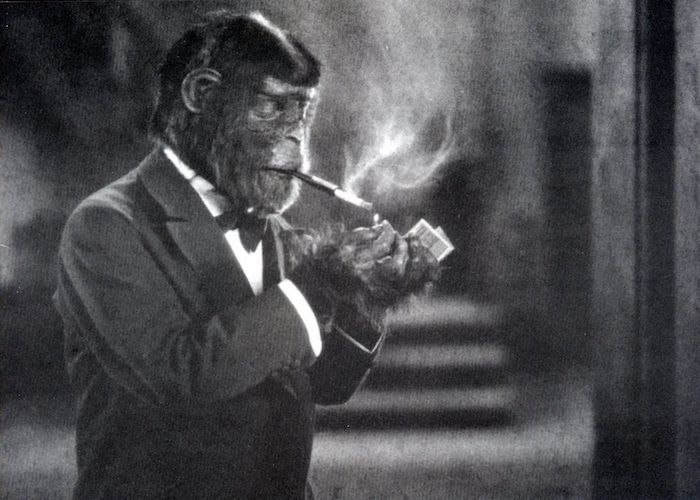
Sticking with the same year but moving to a far less famous or remembered film (yet at the time was quite successful), we can spend the rest of this week’s list with circus-set movies of the early 20th century. The Monkey Talks is a silent drama by Raoul Walsh (White Heat) based on a popular stage show about another struggling big top that finds new fame and fortune with an unbelievable animal star. Here, instead of a flying elephant, the circus presents a talking chimpanzee. Of course, it’s not an actual talking chimpanzee, just an acrobat in a costume.
This movie does have a villain, a lion tamer who kidnaps the new circus star and replaces him with a real chimp. The guy is more like the mean animal tamer at the Medici Bros. circus who ironically dies early on in Dumbo. There’s also a love triangle involving the acrobat, the man who pretends to be his trainer, and a tightrope walker they both fall in love with. And, spoiler alert, this one ends in typical melodramatic tragedy for the main character.
Alice’s Circus Daze (1927)
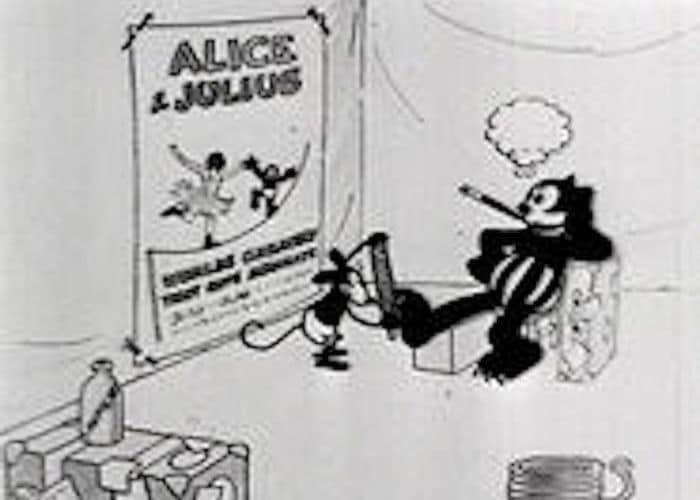
Dumbo might be the most famous Disney movie involving a circus, but the studio has a lot of forgotten films set in the big top or featuring circus performers. Most of them came after the animated Dumbo, including cartoon shorts starring Mickey Mouse (Mickey’s Circus), Goofy (The Big Wash), Pluto (Wonder Dog), and Bongo the bear (Bongo). There are also the 1960s live-action family films Toby Tyler, The Three Lives of Thomasina, and A Tiger Walks. Way before all of them, though, was this short actually helmed by Walt Disney himself.
Alice’s Circus Daze is one of Disney’s live-action and animation hybrid “Alice Comedies,” begun in 1923 with Alice’s Wonderland (fittingly, Disney began his hybrids with something Alice in Wonderland inspired before later turning to the circus, just like Burton) when he was still working with Ub Iwerks at Laugh-O-Gram in Kansas City. This one features the debut of the third Alice actress, Lois Hardwick, and follows the title character and her cat Julius into the circus life. As always in circus stories, morbidly, the film ends with fire breaking out in the big top tent.
Soul of the Beast (1923)

In this silent melodrama, we don’t see too much of the circus. The film begins there, but then follows its protagonist, the stepdaughter of the circus owner, as she flees his abuse. But here there is an elephant. The young woman takes one from the circus as her runaway companion, and the animal also becomes her protector and hero. In the Canadian wilderness, the duo meets another person who has escaped harm — his own animal friend is a rabbit — and he and the woman fall in love. Soul of the Beast stars Madge Bellamy, Cullen Landis, and Oscar the elephant, all of whom were instructed by producer Thomas H. Ince to use “characterization” rather than acting for their performance.
The movie is a lot weirder than it sounds, even with that instruction. Oscar eventually talks (through title cards, of course), though it’s not clear if people can hear him or if he’s just able to communicate with other animals. Also, he can do laundry, babysit, perform his own rescuer action stunts, and even drink beer (everyone caught the Easter egg in the new Dumbo about keeping booze away from the title character, by the way, right?). Also, spoiler alert, the one guy is forced to eat his rabbit friend by the movie’s antagonist. Meanwhile, it’s got an anti-abuse theme, just like Disney’s remake, only it’s focused more on the abuse of children and women and basically enslaved employees as well as on bullying over the bits of animal abuse hinted at in the film.
Jumbo, The Trained Elephant (1919)
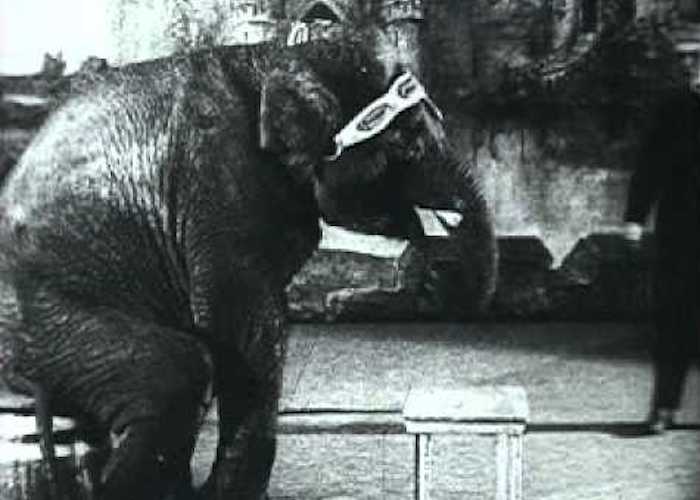
Here’s a film that’s from the exact year of Dumbo‘s setting. Jumbo, The Trained Elephant is not even on IMDb, but the Library of Congress dates the short specifically as being released (or just copyrighted) on April 5, 1919. Produced by Hans Spanuth, who documented circus-type vaudeville acts, this three-to-four-minute film features an elephant named Jumbo doing tricks alongside a dog and a pony. Some videos of the film just title the thing Jumbo the Elephant with Dog and Pony Show.
This Jumbo the elephant is not the Jumbo, of course, as the famous P.T. Barnum attraction was long dead by this time. I also assume there’s no relation between this film and a baby elephant known as Jumbo Junior (same as Dumbo’s original name), which was apparently famous enough to have his own comic strip and get an invite to Buckingham Palace. Jumbo was simply a popular name for pachyderms thanks to that original 19th-century circus star.
Electrocuting an Elephant (1903)
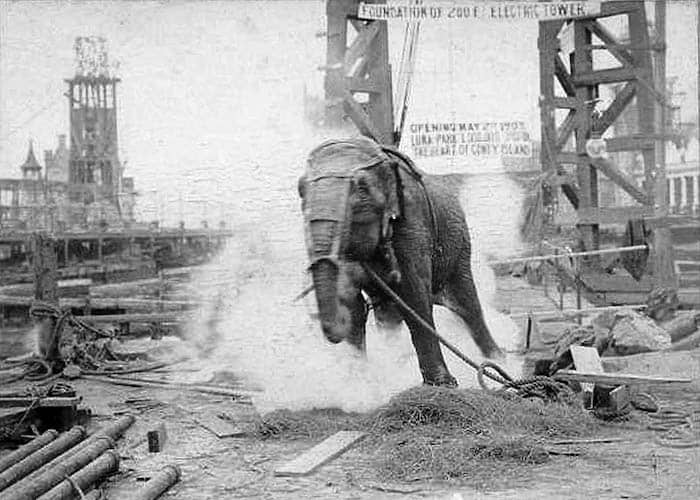
No matter how bad Dumbo and his mother seem to have it at Dreamland in Disney’s new movie (or the original), they’ve got nothing on poor Topsy, the real-life “star” of this week’s documentary pick, Electrocuting an Elephant. The one-minute film depicts the death of the “baby” elephant by electricity, a publicity event that was presented live and here on screen for people’s amusement. How cruel, you say, but at least they didn’t hang the animal, as originally planned, because the ASPCA wouldn’t allow that!
This all happened at the soon to be opened original Luna Park, a famous, spectacular destination spot located at Coney Island, just like the Dreamland of Dumbo (there was a real Dreamland, too, operated by future Ringing Bros. and Barnum & Bailey Circus director Samuel W. Gumpertz, but it burned down eight years before the events of the new movie — Luna Park burned down decades later). And to think that so many believe Walt Disney invented the sort of place seen in the new movie.
Electrical attractions were huge at the Coney Island amusement parks (Steeplechase was another) at that time, with structures covered in light bulbs and even premature babies in newly invented incubators on display, so the execution of a giant creature by electrocution (13 years after the first use of the electric chair for criminals) was something to see. And of course to film, by none other than employees of Thomas Edison, one of the models for the villain in Dumbo. Warning: this famous film is much harder to watch today than it was over a century ago.
Related Topics: Dumbo, Movie DNA, Sunrise, Thomas Edison, Tim Burton, Walt Disney
